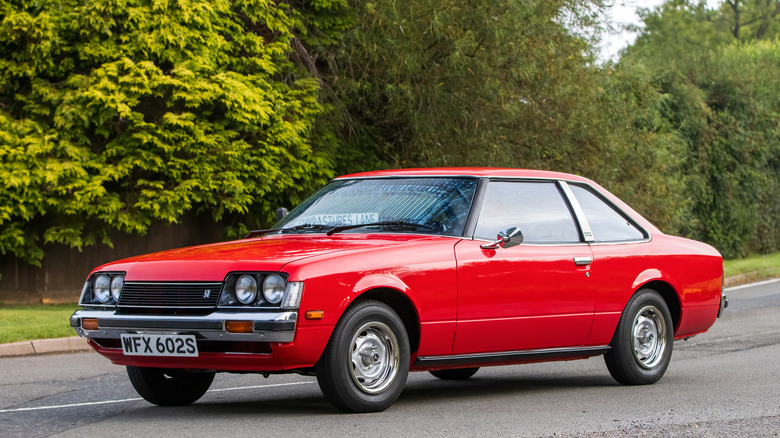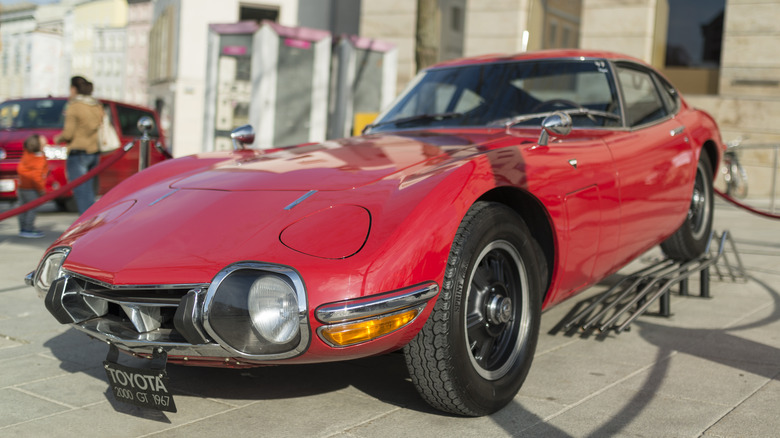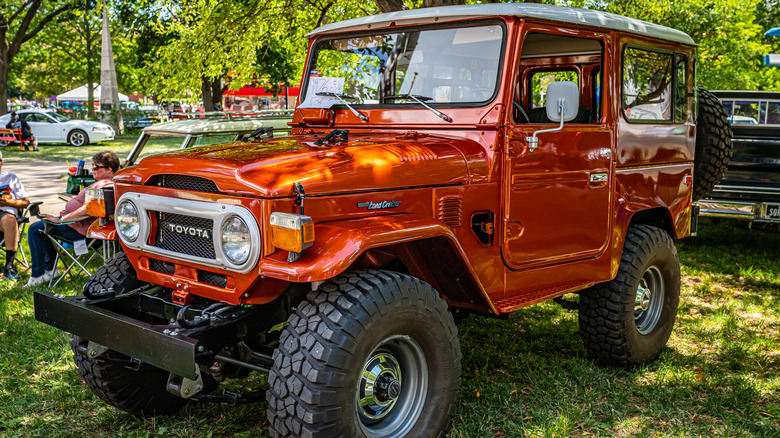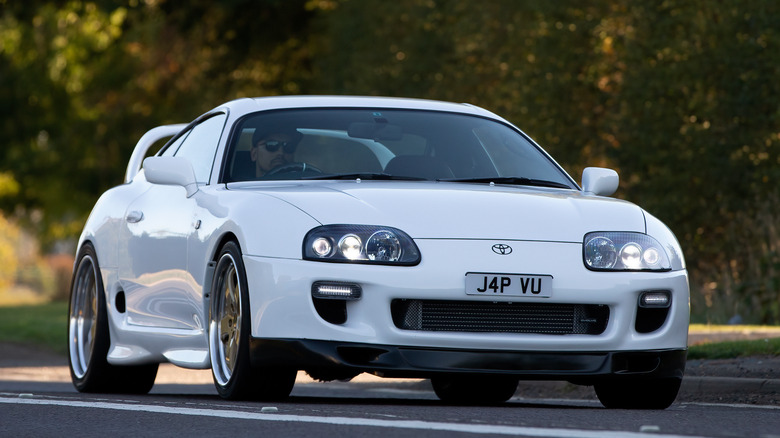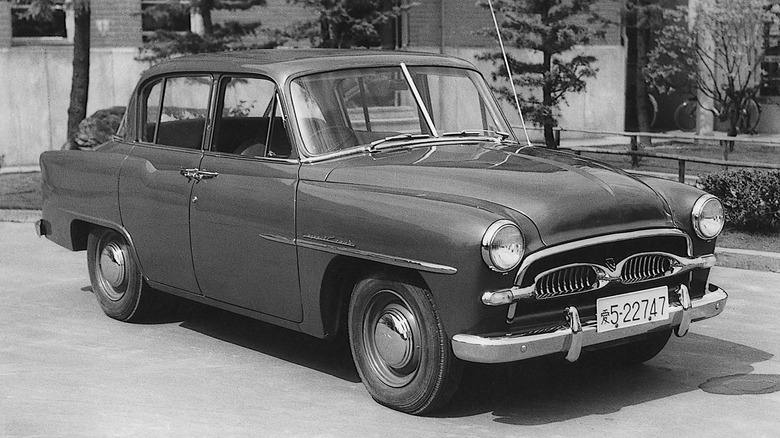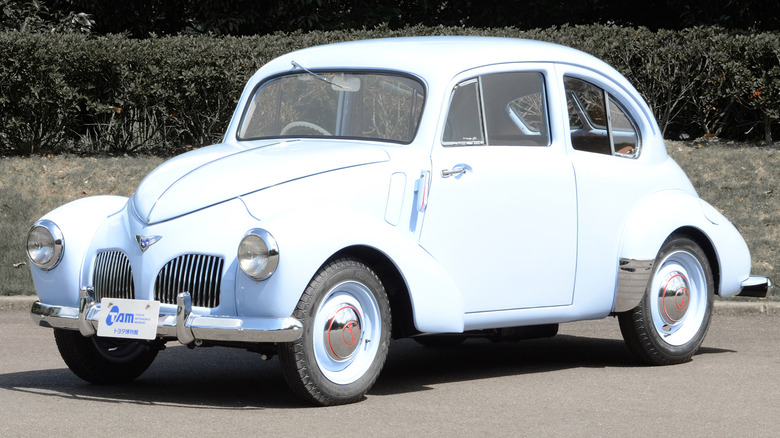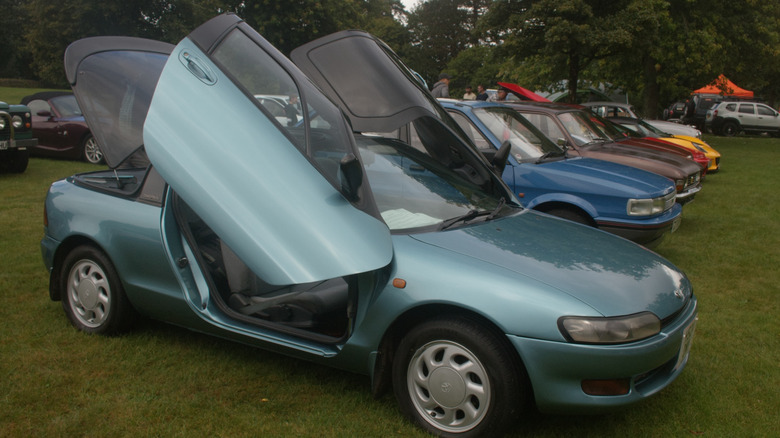10 Old Toyotas That Became Rare Collectibles
In the world of automotive enthusiasts, the allure of rare and collectible cars often extends far beyond the realm of exotic and high-end vehicles. While legendary car makers like Ferrari and Porsche typically steal the spotlight, there's an understated charm in unearthing vintage gems from more everyday manufacturers — which brings us to Toyota, the Japanese automaker known for reliability and practicality.
Toyota may not be the first name that springs to mind when thinking of collectible cars. However, over the years, certain models from Toyota's extensive lineup have achieved cult status and scarcity, making them prized possessions for car aficionados. These vehicles embody the perfect blend of design, performance, and rarity, a combination that piques the interest of discerning collectors. From the charm of vintage Toyota models to the unique stories behind their scarcity, this article will shed light on the unexpected and often underrated heroes of the collector car world.
1. Toyota 2000GT
The Toyota 2000GT is a rare and iconic collectible from the Japanese automaker. This sports car emerged in the Yamaha, featuring a 2.0-liter straight-six engine, delivering 110kW and 175 Nm of power. Drawing inspiration from the Jaguar E-Type, it featured distinctive elements such as unique headlights, a T-shaped chrome grille, and an aerodynamic windscreen. The cabin combined luxury and sportiness, featuring wood and leather accents with a motorsport-inspired design.
Notably, the Toyota 2000GT gained international fame when it appeared in the James Bond movie "You Only Live Twice." The car was modified to accommodate the tall actor Sean Connery, becoming a symbol of Japanese craftsmanship and design excellence. Several decades later, fellow Bond star Daniel Craig revealed that his favorite Bond car is the Toyota 2000GT, too.
The production version was unveiled at the 1966 San Francisco Auto Show and was considered Japan's most expensive car at the time. The 2000GT's rarity, beauty, and engineering excellence have contributed to its status as a highly sought-after classic in the automotive world. It's not only a collector's dream but also a piece of automotive history. In fact, one of the 2000GTs that the legendary Carroll Shelby turned into a competitive race car was sold at an auction for a cool $2.5 million, which makes one wonder what happened to James Bond's 2000GT from "You Only Live Twice."
2. Toyota Celica GT-Four
The Toyota Celica GT-four became a rare collectible for just that reason: rarity. With only 2,500 units produced, of which 2,100 are for the Japanese market, it stands out as a limited-edition gem. These cars were part of Toyota's foray into the World Rally Championship (WRC) and have distinct features such as riser blocks for the rear wing and provisions for an anti-lag system, which are a testament to their motorsport heritage.
In terms of performance, the GT-Four offers a distinctive driving experience. The 3SGTE engine is known for its linear power delivery, and the car's handling is characterized by hefty steering and a progressive engine. The right-hand drive adaptation may require some practice, but it's a rewarding experience for those who appreciate motorsport history.
The Toyota Celica GT-Four's historical significance has also contributed to its status as a collectible to a certain extent. It played a pivotal role in Toyota's rally endeavors, with some creative engineering attempts to manipulate turbo inlet restrictors for added horsepower. This led to a 1996 ban, further adding to its unique history. Despite challenges like limited parts sourcing owing to its rarity, owning one is a dream for collectors and enthusiasts alike.
The GT-Four's significance in Toyota's rally legacy is further emphasized compared to the modern GR Yaris. While the GR Yaris surpasses the Celica in terms of power and speed, the Celica holds its own place in rally history, with predecessors like the ST185 and ST165 winning titles and securing numerous rally victories.
3. Toyota MR2 Spyder
The MR2 Spyder was part of the third generation of the MR2 lineup. It prioritized simplicity and low weight, shedding 700 pounds compared to its predecessors. This focus on keeping the car lightweight contributed to its agility and responsive handling. Despite having a 1.8-liter 1ZZ four-cylinder engine with 138 horsepower, the MR2 Spyder's low weight allowed it to achieve a 0–60 mph time of 6.8 seconds. It may not have been the most powerful sports car, but its nimble character and impressive chassis made it a joy to drive.
The exterior design of the MR2 Spyder is distinctive, featuring "frog-eye" headlights and a blend of boxy and sleek proportions. Its unique appearance sets it apart from other mid-engine sports cars and has contributed to its collectible status. While the interior may be basic compared to more modern sports cars, it offers quality leather elements like the steering wheel, shift knob, and pedals. Surprisingly, it even provides three cup holders for a two-seat car.
One of the key reasons why the MR2 Spyder has become a rare collectible is its limited production. The W30 model was produced from 2000 to 2005, making it rarer than expected. It's often sought after by collectors and enthusiasts due to its unique character and performance. The fact that Toyota has not introduced a direct successor to the MR2 Spyder adds to its collectible allure.
4. Toyota FJ40 Land Cruiser
The Toyota FJ40 Land Cruiser is a rare and coveted collectible with a remarkable 50-year production run. Known for its enduring appeal and straightforward, durable design, the FJ40 has a great reputation among collectors and enthusiasts. This off-road vehicle has a unique charm that continues to make it a sought-after classic in the world of four-wheel drives.
The FJ40 Land Cruiser is characterized by its modest power, off-road prowess, and timeless design. It was built to tackle rugged terrains with ease, and its reliability has contributed to its collectible status. The classic, no-nonsense design of the FJ40 has made it a favorite among off-road adventurers and vintage car enthusiasts.
One reason making the FJ40 Land Cruiser a rare collectible is its limited availability, especially in the United States. Vintage models of the FJ40, produced from 1960 to 1984, have become prized collector's items. While they lack modern comforts, their robustness and reliability have made them highly desirable. High-end restorations of FJ40s can be costly, which has led some collectors to consider importing from overseas markets.
Importing FJ40 Land Cruisers poses its own set of challenges, including dealing with paperwork, regulations, and potential issues like forgeries and trustworthiness in the export process. Registering the vehicle in the U.S. can also be a complex process, varying by state. Despite these hurdles, the appeal of the FJ40 Land Cruiser as a rugged, no-frills, off-road vehicle makes it a valuable addition to any collector's garage.
5. Toyota Supra Mk4
The Toyota Supra Mk4, often referred to simply as the "Mk4 Supra," is a rare and highly coveted Japanese sports car. This generation, produced in the 1990s, is particularly renowned for several key reasons.
The Mk4 Supra offered an unparalleled level of customization. Buyers could choose from various engine configurations, including the highly regarded 3.0-liter straight-six engine. This 2JZ-GTE engine, one of the most reliable Toyota engines ever made and known for its durability and performance capabilities, delivered an impressive 321 horsepower. With advancements in turbocharger technology, this powerplant could be pushed to an astonishing 1,500 horsepower by enthusiasts.
Performance-wise, the Mk4 Supra was a true beast on the road. It boasted a top speed of 177 mph, could accelerate from 0 to 60 mph in just 4.7 seconds, and complete the quarter-mile run in 13.1 seconds at 109 mph. These numbers were nothing short of remarkable for its time and remain impressive today.
One of the standout features of the Mk4 Supra was its affordability during its prime. Costing around $40,000 when new, it's now considered a lucrative investment in the world of collectible cars. Despite the passing years, the Mk4 Supra remains highly sought after, not just for its performance but for its unique blend of power, customization, and legendary 2JZ engine.
The Mk4 Supra came in various configurations, including hardtop and sport roof options. It was also notable for its advanced brake technology, competitive pricing achieved through the use of aluminum and 17-inch wheels, and a unique tire setup with narrower front tires and slightly wider rear tires.
6. Mega Cruiser
Ever wondered what it would look like if the Japanese produced their own take on the Humvee? Well, wonder no longer, as that's essentially what the Toyota Mega Cruiser was. It had some advantages over the Hummer H1, too. It's roomier on the inside, larger all around, but still somehow lighter than its American equivalent.
Very much like the original Hummer, the Mega Cruiser was mainly produced for the Japanese Defense Forces, with around 3,000 going to the Asian nation's military during its production run. Some civilian models also hit the market, but that run was incredibly limited. It's believed that roughly 133 of the large SUVs were produced for the civilian market in total, with only around 20 of those being built in a left-hand drive configuration.
Mega Cruisers were also illegal to import for most of their history, though import-legal examples were available from 2020 onwards. The weird all-terrain monster remains one of the rarest and strangest vehicles in Toyota's historical catalog — and as you may expect, many keen collectors are desperate to get hold of one. As far as pricing goes, it's hard to say. One user on Bring a Trailer bid up to $144,000 for one in April 2024, but that wasn't enough to meet the reserve.
7. Toyopet Crown
When you think about early Japanese cars that sold in the U.S. your mind may be drawn to the likes of the Datsun 240Z, or other 1970s icons. However, Japanese-American automotive history goes back much further than that. The first Japanese car to be sold in the United States was the Toyopet Crown. The vehicle also has the honor of being Toyota's first full-sized passenger vehicle, and is particularly rare these days. An all original model can fetch a hefty fee, especially if it's one of the few U.S. registered cars.
There's a very good reason for the vehicle's scarcity. The Toyopet Crown did well in Japan, but was considered fairly unsuitable for the 1950s U.S. market. James McGraw, Toyota's North American Sales Administrator at the time, summed it up by saying, "This thing is underpowered, overpriced, and it won't sell." The name "Toyopet," which broke down into the connotations "toy" and "pet" may have also conjured images that didn't really appeal to American buyers of the time. Only 287 were sold during the Vehicle's U.S. run. Toyota pulled out of the market in 1960, and only returned after developing something a bit more suitable for American tastes. Despite its initial failure, the Toyopet crown is considered an important part of automotive history, and many Toyota enthusiasts would love to get their hands on one.
8. Toyota WiLL Vi
Every now and then, you'll get signs that automotive executives are a bit out of touch with the youth of the day. One of the best examples is the Toyota WiLL Vi — an odd joint effort from Toyota and a host of leading Japanese companies that looks like it may actually be the result of a collaboration between Homer Simpson and Pablo Picasso. The WiLL Vi, which Toyota actually managed to avoid putting its badge on, was also built with sustainable materials and was geared towards fuel economy. You know, because that's what the kids wanted back then or something. The badge you may spot on the front of one, if you ever do see a WiLL Vi around, is that of Toyota subsidiary WiLL — which launched with this monstrosity and died in 2005.
Like Godzilla attacks, the WiLL Vi was very much restricted to Japan and the rest of the world was spared its presence. Only 16,000 or so were sold during its two-year production run, so it wasn't exactly a success. However, the first WiLL Vis to roll off the production line will become import-legal in the United States at some point in 2025. Given its rarity, and unique appearance, there's a good chance that the WiLL Vi may become an obscenely desirable and collectible vehicle in the Americas. It certainly ticks all the boxes, and many collectors gravitate towards vehicles that will make passers-by think, "what on Earth is that?" And that's probably the one thing Toyota's weird early 2000s spin-off excelled at.
9. Toyopet SA
Before the Crown came the SA, a compact vehicle produced in the wake of World War II. It was the brand's first car after the war, but was delayed somewhat when Toyota decided to focus on the SB truck. The Toyota SA featured independent front and rear suspension, with coil springs used at the front. It was a sportier rethink of the AA, Toyota's first passenger car, and took a lot of inspiration from the VW Beetle. Up front, it boasted a 27 hp Model S engine, just like the SB. There were also a few countries still banning Japanese imports when the SA was announced, due to what could politely be described as "global political tensions" a few years earlier.
As for collectibility, the SA is not just one of Toyota's rarest vehicles, but one of the rarest vehicles on earth. It was announced in 1947, and production only ran until 1952. In that time, only 215 units rolled off the production line. Although the vehicles are obviously far more than 25 years old and can be legally imported into the U.S. as classics, finding one may be incredibly difficult. None of the original run was sold in the United States, and many of the 215 that were built won't have survived the following decades. It's hard to find info on just how many still exist, and harder still to find one listed for sale. So where price is concerned, your guess is as good as ours.
10. Toyota Sera
Nothing says sportiness and performance like a two-seater car with butterfly doors. Surprisingly, an early 90s vehicle with that design, and an alleged inspiration for some elements of the McLaren F1, wasn't really sporty at all. The Sera was designed to meet the demands of American commuters at the time, while having a unique look. So it got great gas mileage (for the early 90s), was incredibly reliable, and was compact enough to contend with increasingly congested cities.
Unfortunately, the design resulted in the National Highway Traffic Safety Administration (NHTSA) stepping in and outright banning the Sera. As Toyota had designed the vehicle with the American market very much in mind, this was pretty much a death sentence for the plucky little two-door motor. Rather than go back to the drawing board and produce what would essentially be a top to bottom rework of the Sera to tick some NHTSA boxes, Toyota just produced around 16,000 for the Japanese market before calling it a day in 1995.
Despite initially being very illegal, there is a well-known loophole that makes the Toyota Sera good to go as of 2024. Cars that left the factory 25-years ago or earlier are legal to import, register, and drive in the United States. Despite its rarity and collectibility, the Sera isn't obscenely expensive, with recent examples in the U.S. selling for somewhere around the $10,000 mark.
